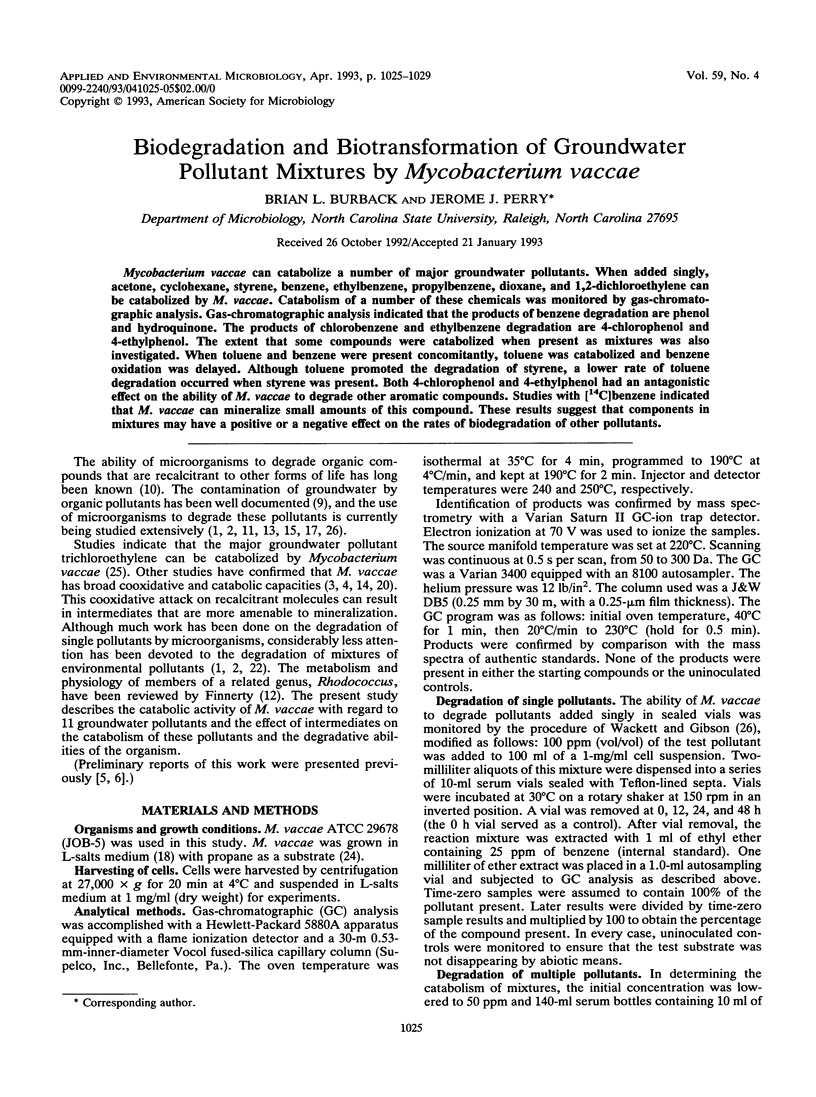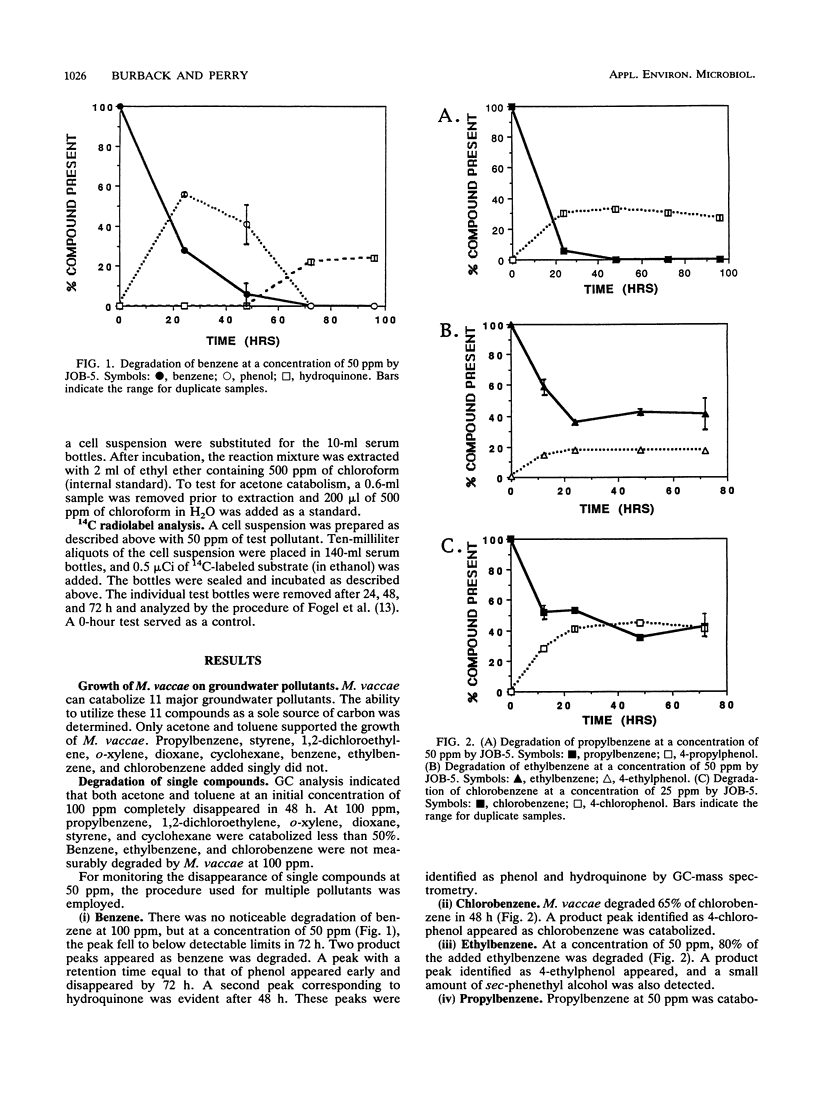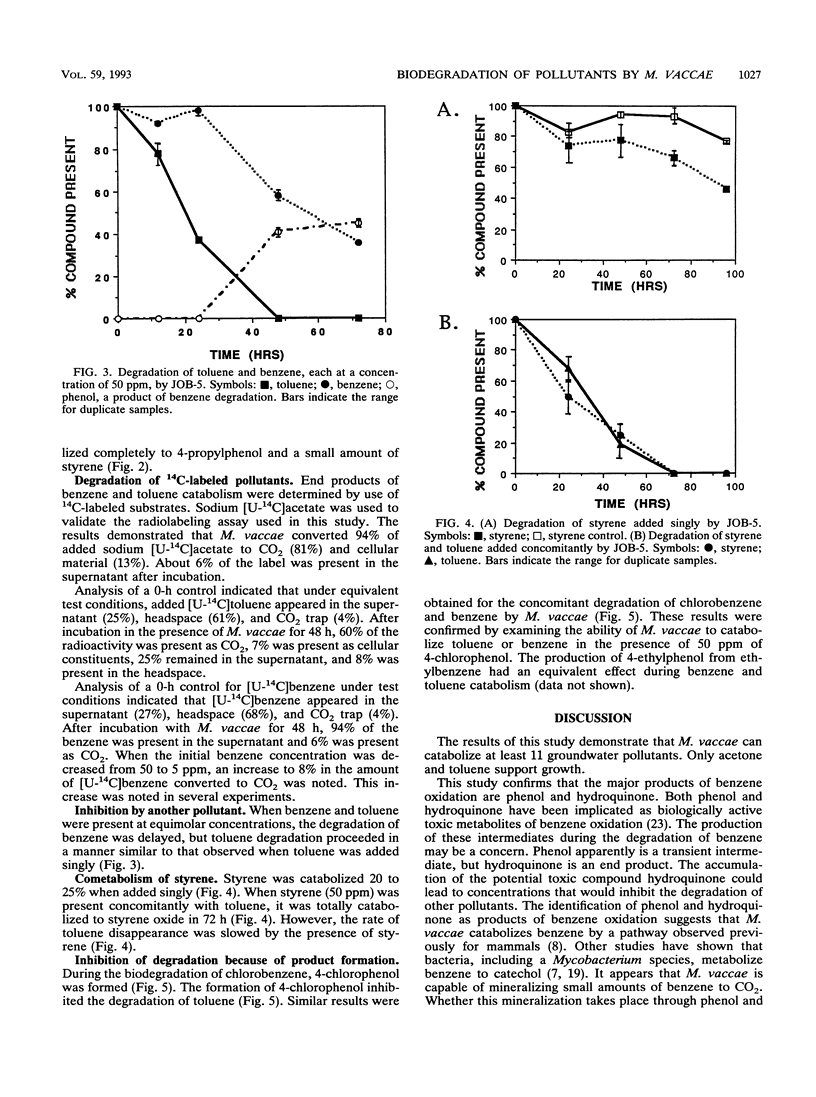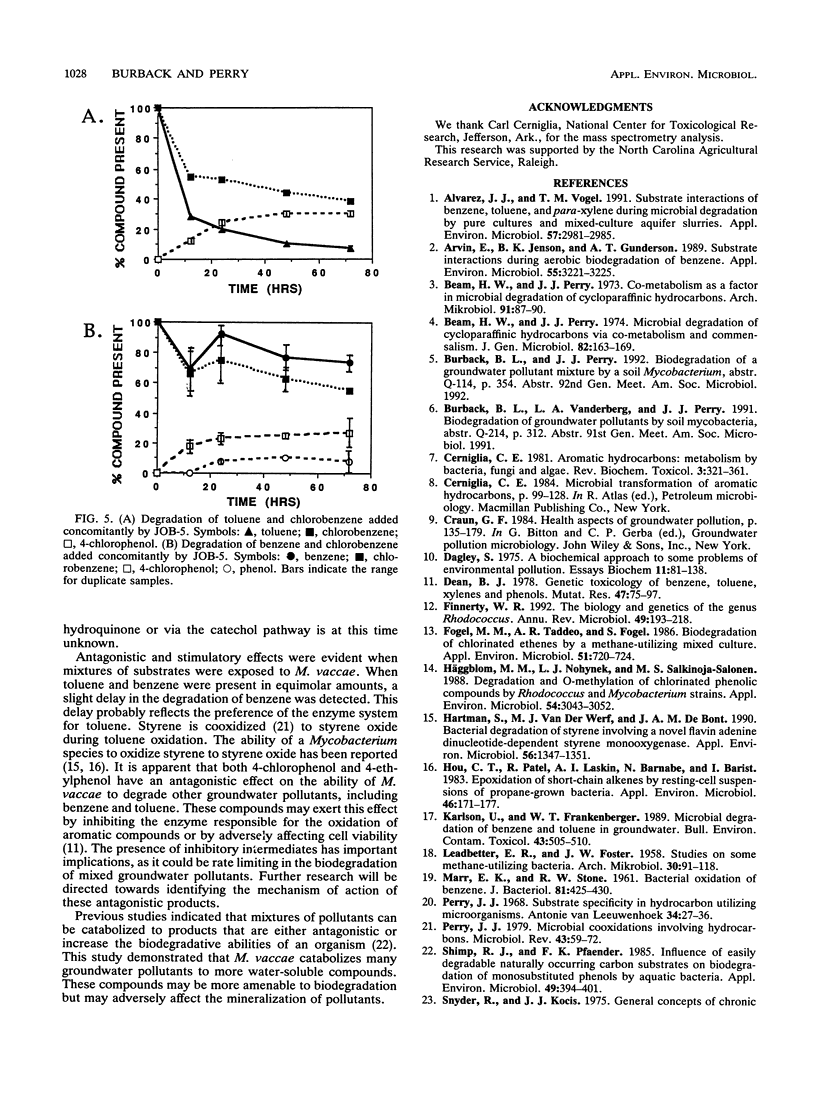Abstract
Mycobacterium vaccae can catabolize a number of major groundwater pollutants. When added singly, acetone, cyclohexane, styrene, benzene, ethylbenzene, propylbenzene, dioxane, and 1,2-dichloroethylene can be catabolized by M. vaccae. Catabolism of a number of these chemicals was monitored by gas-chromatographic analysis. Gas-chromatographic analysis indicated that the products of benzene degradation are phenol and hydroquinone. The products of chlorobenzene and ethylbenzene degradation are 4-chlorophenol and 4-ethylphenol. The extent that some compounds were catabolized when present as mixtures was also investigated. When toluene and benzene were present concomitantly, toluene was catabolized and benzene oxidation was delayed. Although toluene promoted the degradation of styrene, a lower rate of toluene degradation occurred when styrene was present. Both 4-chlorophenol and 4-ethylphenol had an antagonistic effect on the ability of M. vaccae to degrade other aromatic compounds. Studies with [14C]benzene indicated that M. vaccae can mineralize small amounts of this compound. These results suggest that components in mixtures may have a positive or a negative effect on the rates of biodegradation of other pollutants.
Full text
PDF




Selected References
These references are in PubMed. This may not be the complete list of references from this article.
- Alvarez P. J., Vogel T. M. Substrate interactions of benzene, toluene, and para-xylene during microbial degradation by pure cultures and mixed culture aquifer slurries. Appl Environ Microbiol. 1991 Oct;57(10):2981–2985. doi: 10.1128/aem.57.10.2981-2985.1991. [DOI] [PMC free article] [PubMed] [Google Scholar]
- Arvin E., Jensen B. K., Gundersen A. T. Substrate interactions during aerobic biodegradation of benzene. Appl Environ Microbiol. 1989 Dec;55(12):3221–3225. doi: 10.1128/aem.55.12.3221-3225.1989. [DOI] [PMC free article] [PubMed] [Google Scholar]
- Beam H. W., Perry J. J. Co-metabolism as a factor in microbial degradation of cycloparaffinic hydrocarbons. Arch Mikrobiol. 1973 Apr 8;91(1):87–90. doi: 10.1007/BF00409542. [DOI] [PubMed] [Google Scholar]
- Dagley S. A biochemical approach to some problems of environmental pollution. Essays Biochem. 1975;11:81–138. [PubMed] [Google Scholar]
- Dean B. J. Genetic toxicology of benzene, toluene, xylenes and phenols. Mutat Res. 1978;47(2):75–97. doi: 10.1016/0165-1110(78)90014-3. [DOI] [PubMed] [Google Scholar]
- Finnerty W. R. The biology and genetics of the genus Rhodococcus. Annu Rev Microbiol. 1992;46:193–218. doi: 10.1146/annurev.mi.46.100192.001205. [DOI] [PubMed] [Google Scholar]
- Fogel M. M., Taddeo A. R., Fogel S. Biodegradation of chlorinated ethenes by a methane-utilizing mixed culture. Appl Environ Microbiol. 1986 Apr;51(4):720–724. doi: 10.1128/aem.51.4.720-724.1986. [DOI] [PMC free article] [PubMed] [Google Scholar]
- Hartmans S., van der Werf M. J., de Bont J. A. Bacterial degradation of styrene involving a novel flavin adenine dinucleotide-dependent styrene monooxygenase. Appl Environ Microbiol. 1990 May;56(5):1347–1351. doi: 10.1128/aem.56.5.1347-1351.1990. [DOI] [PMC free article] [PubMed] [Google Scholar]
- Hou C. T., Patel R., Laskin A. I., Barnabe N., Barist I. Epoxidation of short-chain alkenes by resting-cell suspensions of propane-grown bacteria. Appl Environ Microbiol. 1983 Jul;46(1):171–177. doi: 10.1128/aem.46.1.171-177.1983. [DOI] [PMC free article] [PubMed] [Google Scholar]
- Häggblom M. M., Nohynek L. J., Salkinoja-Salonen M. S. Degradation and O-methylation of chlorinated phenolic compounds by Rhodococcus and Mycobacterium strains. Appl Environ Microbiol. 1988 Dec;54(12):3043–3052. doi: 10.1128/aem.54.12.3043-3052.1988. [DOI] [PMC free article] [PubMed] [Google Scholar]
- Karlson U., Frankenberger W. T., Jr Microbial degradation of benzene and toluene in groundwater. Bull Environ Contam Toxicol. 1989 Oct;43(4):505–510. doi: 10.1007/BF01701927. [DOI] [PubMed] [Google Scholar]
- LEADBETTER E. R., FOSTER J. W. Studies on some methane-utilizing bacteria. Arch Mikrobiol. 1958;30(1):91–118. doi: 10.1007/BF00509229. [DOI] [PubMed] [Google Scholar]
- MARR E. K., STONE R. W. Bacterial oxidation of benzene. J Bacteriol. 1961 Mar;81:425–430. doi: 10.1128/jb.81.3.425-430.1961. [DOI] [PMC free article] [PubMed] [Google Scholar]
- Perry J. J. Microbial cooxidations involving hydrocarbons. Microbiol Rev. 1979 Mar;43(1):59–72. doi: 10.1128/mr.43.1.59-72.1979. [DOI] [PMC free article] [PubMed] [Google Scholar]
- Perry J. J. Substrate specificity in hydrocarbon utilizing microorganisms. Antonie Van Leeuwenhoek. 1968;34(1):27–36. doi: 10.1007/BF02046411. [DOI] [PubMed] [Google Scholar]
- Shimp R. J., Pfaender F. K. Influence of easily degradable naturally occurring carbon substrates on biodegradation of monosubstituted phenols by aquatic bacteria. Appl Environ Microbiol. 1985 Feb;49(2):394–401. doi: 10.1128/aem.49.2.394-401.1985. [DOI] [PMC free article] [PubMed] [Google Scholar]
- Vestal J. R., Perry J. J. Divergent metabolic pathways for propane and propionate utilization by a soil isolate. J Bacteriol. 1969 Jul;99(1):216–221. doi: 10.1128/jb.99.1.216-221.1969. [DOI] [PMC free article] [PubMed] [Google Scholar]
- Wackett L. P., Brusseau G. A., Householder S. R., Hanson R. S. Survey of microbial oxygenases: trichloroethylene degradation by propane-oxidizing bacteria. Appl Environ Microbiol. 1989 Nov;55(11):2960–2964. doi: 10.1128/aem.55.11.2960-2964.1989. [DOI] [PMC free article] [PubMed] [Google Scholar]
- Wackett L. P., Gibson D. T. Degradation of trichloroethylene by toluene dioxygenase in whole-cell studies with Pseudomonas putida F1. Appl Environ Microbiol. 1988 Jul;54(7):1703–1708. doi: 10.1128/aem.54.7.1703-1708.1988. [DOI] [PMC free article] [PubMed] [Google Scholar]


